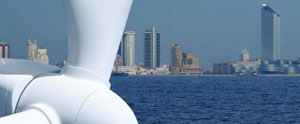It looks like Scotland has trumped Donald Trump by approving two massive offshore wind farms he tried so hard to derail – together, they will supply over a million households with electricity … while ruining the view from his golf course.
Located side-by-side, 326 turbines will produce 1.9 gigawatts of energy off the Caithness coast – the world’s third largest offshore wind farm. It’s expected to inject some £2.5 billion into Scotland’s economy, employing 4600 people at peak construction and 580 permanent jobs.
The two wind farms alone could provide 40% of Scotland’s peak power on windy days. Trump railed against them after building a development the government should never have allowed in the first place.
They will bring Scotland significantly closer to its goal of switching entirely to renewable energy by the end of this decade.
The view from Trump’s golf course:

Located 14 miles from shore, "This is a critical step in the development of offshore wind in deeper water, further from shore," says João Manso Neto, CEO of EDP Renováveis. It will provide a significant new generation resource at a time when aging thermal power stations are coming off-line and gas prices are rising. It will deliver improved security of supply, and greater insulation for consumers from volatile fossil fuel prices."
The bigger wind farm, Moray Firth, is a 1.1 GW project that spans three sites, each consisting of 62 of the world’s biggest turbines. At 6-8 MW, each wind turbine will be 670 feet tall. It’s being developed as a joint venture between oil and gas company Repsol and utility EDP Renewables.
Next door, Beatrice Offshore Windfarm will be 750 MW, also developed by a joint venture led by Britain’s SSE Renewables.
Environment groups are welcoming the project but its enormous size could be deleterious to wildlife. Scottish officials say project approvals rest on careful monitoring of potential impacts, but environmental group RSPB Scotland (Royal Society for the Protection of Birds) would have preferred a smaller array.
"We will be looking closely at the details of the consent over the next few days but we believe a smaller development could have provided very significant amounts of renewable energy with much less risk to marine wildlife," Aedan Smith, head of planning and development of RSPB told BBC.
The Scottish Fishermen’s Federation also wants to be fully informed and consulted on offshore wind developments.
Scotland is also leading on marine energy, approving the world’s first significant-sized wave and tidal projects in Pentland Firth, called the "Saudi Arabia of tidal power." Luckily that won’t ruin Trump’s view.
Last year, the UK approved the 1.2 GW Triton Knoll Wind Farm as the first phase of the 830 MW London Array came online. Because of the boom in offshore wind, Siemens – which makes the wind turbines most commonly used – announced it will invest £160 million in two manufacturing plants there. It will create 1000 jobs!
"The offshore wind market in Great Britain has high growth rates, with an even greater potential for the future. Wind power capacity has doubled here within two years, to roughly 10 gigawatts. By 2020, a capacity of 14 gigawatts is to be installed at sea alone to combine the country’s environmental objectives with secure power supply. Projects for just over 40 gigawatts are currently in the long-term planning," Michael Suess of Siemens told The Guardian.
Mainly because of rising wind capacity, renewable energy rose 28% last year in the UK, to 14.8% of the country’s energy mix, reports the UK Department of Energy and Climate Change. Onshore wind rose 36% (to 16.5 terawatt-hours), offshore wind rose 46% (to 16.5 terawatt-hours) and solar rose 70% (to 2 terawatt-hours).
Meanwhile in New Jersey
Offshore wind, which could make a big impact off the coast of New Jersey, has been rejected again – officials said no to even the small pilot project proposed by Fishermen’s Energy.
If it had been approved, it would have been the first grid-connected offshore wind farm in the US.

The state’s Board of Public Utilities unanimously voted against a funding mechanism for the $188 million, Atlantic City Offshore Wind Farm. Just five turbines would be built three miles off the coast, generating about 25 MW of electricity.
Why? If Fisherman’s doesn’t end up qualifying for the mix of subsidies needed to pay for it, ratepayers would be left with higher utility bills.
According Fisherman, which plans to go to court, they used old figures to do their analysis on how much electricity would cost – $263 per megawatt-hour versus the company’s proposed $199 per megawatt-hour.
The issue for New Jersey in making this decision is that it will lose to other states like Maryland that are aggressively supporting offshore wind.
"The real issue with being first is attracting the industry investment and supply chain. And so, unfortunately, New Jersey, by saying no, just makes it clear it’s not interested in those jobs and that investment," Chris Wissemann, CEO of Fishermen’s, told Philadelphia Inquirer.
Back in 2008, then-Governor Corzine announced plans to make New Jersey a world leader in offshore wind with 3 GW by 2020. At that level, it would provide 13% of the state’s energy, 800,000 to almost 1 million homes. That has since been cut to 1.1 GW during that time frame.
